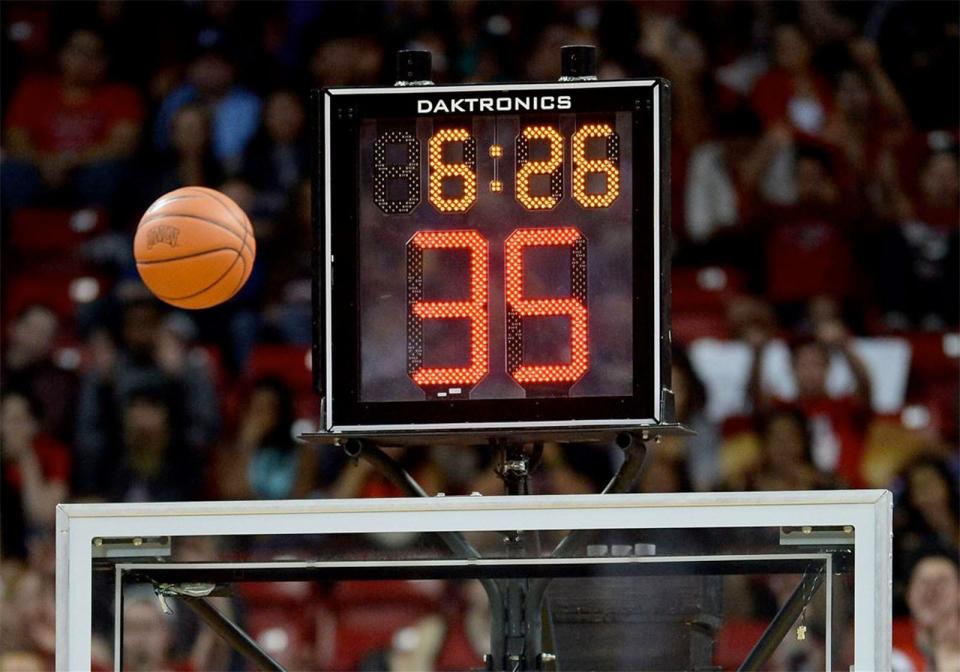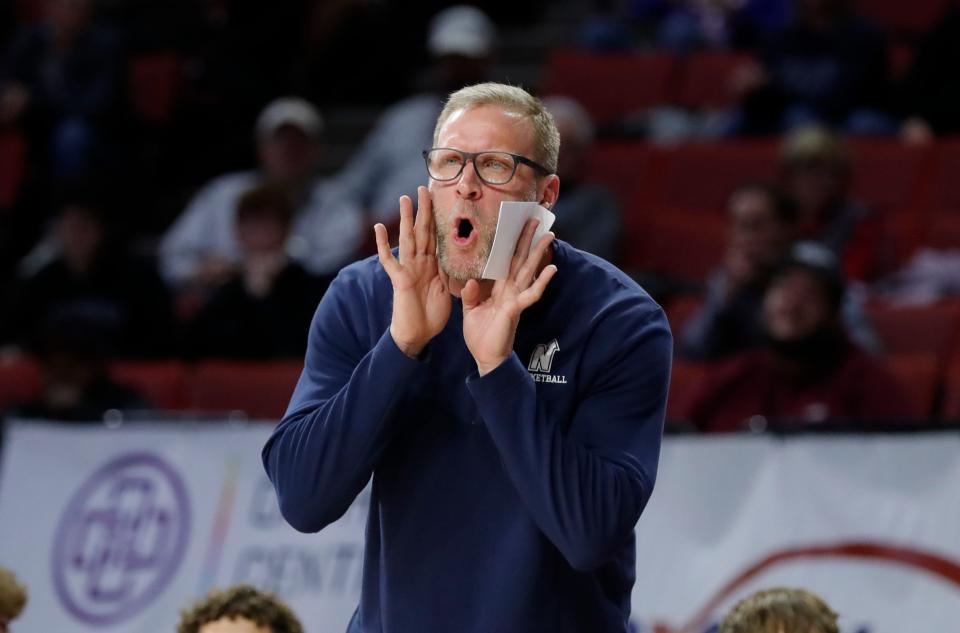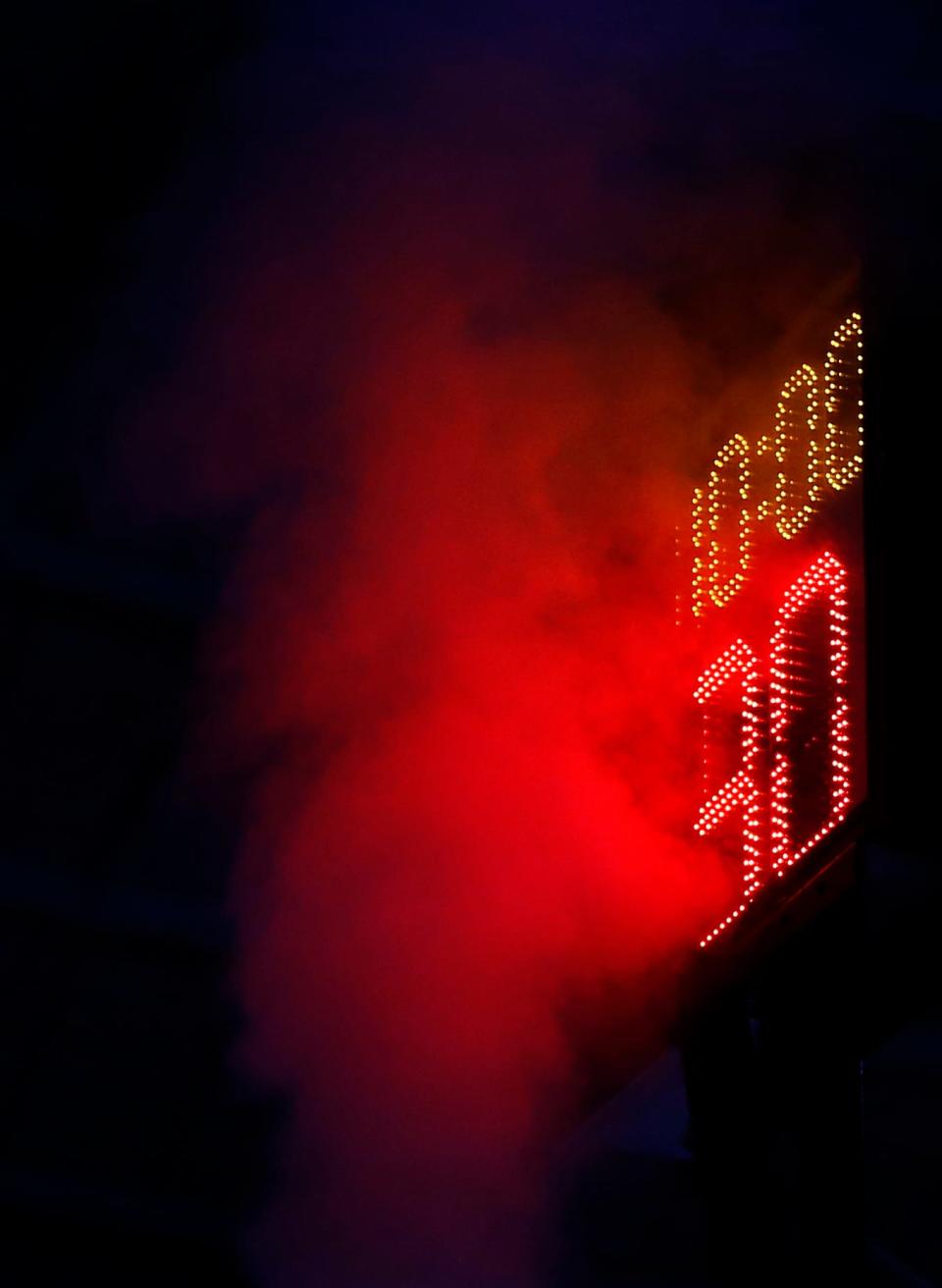Why do Oklahoma HS basketball coaches keep advocating for a shot clock? 'Change is good.'

With an attentive audience of more than 100 high school athletic directors, Mark Daigneault made his opinion clear.
As the Oklahoma City Thunder coach opened the floor for questions, embracing his role as the guest speaker at the Central Oklahoma Athletic Directors Association’s February meeting, the conversation could have veered nearly any direction — but it headed straight for the shot clock.
Daigneault laughed and said it was a planted question when someone kicked off the Q&A session asking for his thoughts on the hot topic in high school basketball. He wanted to dig into it, talking for several minutes as a “pro-shot clock guy.”
Incorporating that time element into the game forces players to make more decisions and improves their skill, he said.
Many high school coaches and administrators agree.
And they continue to advocate for the change after the Oklahoma Secondary School Activities Association Board of Directors denied it with a close vote.
More:Meet The Oklahoman’s initial 2024 Super 30 rankings of the state's top college football prospects

“I think we just need to look forward and invite progress,” said Scott Norris, Class 6A Edmond North’s boys basketball coach. “Sometimes, change is good.”
Conversations about the 35-second shot clock in Oklahoma high school basketball are spreading beyond coaches’ offices, drifting out of gyms and making their way across the state. Even Daigneault, who doesn’t pretend to be in the loop about many Oklahoma sports topics outside the walls of Paycom Center, chimed in. The steady boil has turned into a sizzle thanks to a couple of recent headlines.
Jan. 11: With an 8-7 vote, the Oklahoma Secondary School Activities Association denied a recommendation to implement the shot clock in Classes 6A-3A for the 2024-25 season despite favorable survey results from coaches and administrators.
Feb. 7: the 4-2 game happened.
The Class 4A Anadarko boys basketball team used the polarizing “stall ball” strategy, holding the basketball for as long as possible, but fell to Weatherford in a 4-2 matchup that grew into a national fascination.
With no shot clock, it was permissible.
As the postseason begins, nothing stops teams from doing it again.
Here’s the burning question: what happens next in the shot clock debate?
“I don’t really know, but I’m sure in the future it will be revisited at some point,” said OSSAA staff member Brian Lester, who presides over Classes 4A-B basketball. “I’m not saying anytime soon or anything like that.
“I’m just saying I know that’s a debate all across the United States for those states that have not adopted it yet, and I’ve talked to some other associations – they’re kind of where we are. They have some people that want it and some people that, they don’t.”
For those speaking out in favor, the reasoning goes far beyond preventing the occasional stall.
More:Tramel's ScissorTales: How to fix Oklahoma high school basketball playoff format
Why does adding a shot clock matter for high school basketball?
Shane Cowherd remembers the doubters.
In the late 1980s-early ’90s, traditionalists argued a new element of high school basketball would ruin the game.
It was called the 3-point line.
Opposition to change is nothing new, but the high school game has evolved tremendously in recent decades, from adding 3-pointers to doing away with halfcourt 6-on-6 girls basketball so everyone could play 5-on-5.
As one of the shot clock’s strongest advocates, Cowherd sees the benefits of those advancements.
“Anything that we can do to help our kids enjoy and think (about) the game at a higher level is a win for basketball,” said Cowherd, Class 6A Edmond Memorial’s boys hoops coach.
Cowherd said he wants it because of strategy. In the final minute of a game, a coach could try to calculate how many more possessions the team might get and work from there. Can the team play lockdown defense for 35 seconds and get the ball back? Or should someone foul?
The pace picks up, and the strategy is on par with college basketball, preparing kids who aspire to play at the next level.
Megan Knight, Class 6A Midwest City’s girls basketball coach, said this is a reason she favors the shot clock. She is familiar with the learning curve from high school to college.
“I coached at the collegiate level for five years,” Knight said, “and that was one of the biggest struggles for incoming freshmen with the pace of game.”
More:Piper McNeil breaks Oklahoma HS swimming records, leads Shawnee to second straight 5A title

Not all recruits have to wait until college to encounter the shot clock. Frankie Parks, Class 6A Norman's girls basketball coach, pointed out that some of his players use it during club basketball in the spring and summer.
And in some surrounding states, the shot clock has already reached school ball. In May 2021, the National Federation of State High School Associations announced state associations could introduce the 35-second shot clock starting in the 2022-23 season.
The majority of states don’t have it, but around a dozen have jumped on board.
Although she can’t use the shot clock in Oklahoma, Jenni Holbrook has already introduced it to her Class 3A Jones girls basketball team at a tournament in Arkansas, where it’s part of the game. Holbrook said she initially had her doubts, but the shot clock won her over.
“It was a game inside of a game,” Holbrook said. “I loved coaching a possession within that time frame.”
Walter Brewer had a similar experience when his Class 5A Southeast boys basketball team opened the season in Arkansas. The Spartans stormed past Fort Smith Southside, 81-59, and Brewer said everything went smoothly.
Although he liked the pace, he doesn’t want to impose a rule change on everyone.
“If the small schools don’t want it, then let them do what they’ve been doing,” Brewer said. “But the schools that want it, let them have the shot clock.”
Brewer’s straightforward stance reflects the results from the OSSAA’s surveys.
For clarity: the OSSAA board and staff are separate entities. Before the board voted, the staff conducted these polls.
The majority of Class 2A-6A coaches who responded voted in favor of the shot clock, while most A-B respondents opposed it. The administrator survey looked similar, except 2A administrators had less favorable answers, hence the recommendation for Classes 6A-3A only.
In Class 6A, 90% of coach respondents voted for the shot clock.
The overwhelming results have left many, like Cowherd, frustrated that the board ignored their voices after the staff presented the findings.
“I think that the OSSAA officers that were in charge of this did a great job in being able to get the data and the information,” Cowherd said. “All of it was done well to show that this is something we want; this is something that we feel that we also need.
“And then for whatever reason, the board dropped the ball.”
More:Keeley Parks leads Norman girls with 33 points, Norman boys avenge Edmond Memorial loss
What are the obstacles for the OSSAA to add a shot clock?
Rex Trent said he was trying to represent his quadrant.
Trent, the OSSAA Board of Directors president, cast the tiebreaker vote against the shot clock recommendation.
Appointed to the board by the Southwest Quadrant of Oklahoma, he said he focused more heavily on feedback from schools in his quadrant than on the survey results. Trent – the superintendent of Binger-Oney, a Class A basketball school – said he talked to people from “a variety” of schools, though he didn’t clarify their classifications.
“I do my due diligence, and I communicate with the majority of the people that I can in the Southwest Quadrant to get their feeling on the agenda item,” Trent said. “At that point in time, I did not have enough response positively for a 35-second shot clock.”
Clearly, he didn’t stand alone – to reach the gridlock, seven board members voted against the shot clock. Of the eight opponents, five are from small schools not included in the Class 6A-3A recommendation, but doubts also exist in larger schools. Class 6A Lawton superintendent Kevin Hime, a board member who voted no, said he heard concerns about finding people to run the clock, maintaining it and potentially putting extra pressure on officials.
Jared Reese, Class 4A Kingfisher’s boys basketball coach, mentioned another common concern: cost. The prices of shot clock systems vary widely, but they can rise into the thousands, a legitimate obstacle as public schools across the state receive inadequate funding.
Although Knight favors the shot clock, she can empathize with administrators at rural schools. Her father, Mark Maloy, is the superintendent at Class B Earlsboro, so she said she understands how the price tag could negatively impact small schools.
But if it were financially feasible for every school to obtain a shot clock, would there still be hold-outs? Of course. Just as staunchly as the majority of Class 6A-3A coaches advocate for the shot clock, a few stand against it.
Even some who said “yes” on the survey have conflicting opinions. Michael Jeffries, Class 3A Millwood’s boys basketball coach, said he sees the pros and cons. While many coaches like the idea of making high school more similar to college basketball, Jeffries said he prefers to keep the levels distinct. Still, he voted for the shot clock.
So did most of his fellow respondents in Class 3A and above, yet they continue to wait for a turning point.
More:Oklahoma high school swimming: Edmond North boys edge Jenks for Class 6A state title
What happens next in the great shot clock debate?
Brian Lester noticed the impact of the 4-2 game.
Seeing the extreme example of stall ball, fans and casual observers took to Twitter to demand a shot clock, expanding the conversation beyond the coaching world. Lester said the OSSAA heard from pro- and anti-shot clock people after the board’s vote, and the voices in favor of the shot clock increased after that bizarre matchup.
While some coaches were appalled at the game’s result, Holbrook didn’t blame Anadarko for using an approach within the rules.
“If a team feels like they can stall the ball or hold the ball or do what they can because that’s the best chance they have of winning, then I say go for it,” Holbrook said. “If we feel like that’s such a violation of basketball ethics, then the shot clock needs to be implemented immediately.”
For now, the OSSAA’s action has come to a standstill. OSSAA staff member Amy Cassell, who administered the surveys with Lester, said in an email that “nothing has changed with the shot clock.”
The staff could conduct as many surveys as they want, but something would have to sway the board.
After seeing board members’ votes run contrary to the survey results, Cowherd wonders if the board’s process should change. He proposed a couple of ideas: narrowing the vote to only board members representing the classifications affected by an issue or leaving the vote up to member schools instead of the board.
Cowherd questioned why administrators from Class A schools, for example, were voting on a recommendation limited to Classes 6A-3A.
If present members affiliated with only Classes 6A-3A had voted Jan. 11, then the shot clock would have passed, 6-3.
“Now, it’s the OSSAA’s job to figure out a way to be able to fix that issue and change from what is a very archaic way of doing business for high school sports in our state,” Cowherd said. “We can be better.”
Even without a massive OSSAA change, board members could shift their stances as they gather more information.
“This item may come back up as an agenda item and get voted on again, and it could change,” Trent said. “But on that particular day, that’s how it turned out.”
More:Why is Crooked Oak retiring a current player's jersey? 'It’s more than just the points'
Holbrook has heard an idea that could be easier for schools to handle: breaking the sweeping recommendation for Classes 6A-3A into a gradual approach.
Teams that host tournaments could start using the shot clock during those events only, she said, or 6A-5A programs could do a trial run. Parks said he also thinks tournaments would be a "great start."
“You could work out all the kinks with bigger schools with bigger budgets and kind of see what exactly the cost would be,” Holbrook said. “Maybe those smaller schools are put on a timeline of, ‘OK, within five years, six years, this is a cost to have to put in your budget by the time it trickles down to the smaller schools that have the smaller budgets.’”
Some schools have already started preparing. Reese said he figures the shot clock will receive approval eventually, and at several schools, administrators have discussed logistics.
At Carl Albert, preparation began about 20 years ago when the gym was built.
Boys basketball coach Jay Price said shot clocks were mounted on the goals, equipping the venue to host events such as college tournaments.
This postseason, as high school basketball teams travel to Carl Albert and other schools equipped with shot clocks, no red neon lights will fill their displays. No buzzer will sound after 35 seconds.
The rectangles that sit atop the goals will remain blank, staying that way for at least one more season.
But their existence offers the possibility of a faster-paced future many coaches and basketball fans continue to champion.
This article originally appeared on Oklahoman: Oklahoma high school basketball coaches push to add shot clock

